Assessment 2: Leading Communication Practices in the Workplace - MMI
VerifiedAdded on 2022/12/07
|40
|8002
|71
Project
AI Summary
This assessment project focuses on leading and managing communication practices within the context of MMI, a company opening a new campus. The project encompasses establishing communication protocols, coordinating effective communication, and reviewing existing communication processes. The student, in the role of a Communication Liaison Leader, analyzes internal and external information needs, develops communication protocols, prepares supporting materials, and addresses communication challenges. Key deliverables include a communication needs analysis, improvements to policies, a code of conduct, virtual meeting etiquette, an email to staff, an action plan, planning notes for a mentoring session, a PowerPoint presentation, and feedback forms from role-plays. The assessment also involves direct observation of role-plays for mentoring, presentation, and negotiation skills, culminating in an email to key stakeholders with an action plan. The project demonstrates the student's ability to analyze information needs, develop communication strategies, direct others, explain complex information, identify and address communication challenges, and negotiate towards a final outcome.
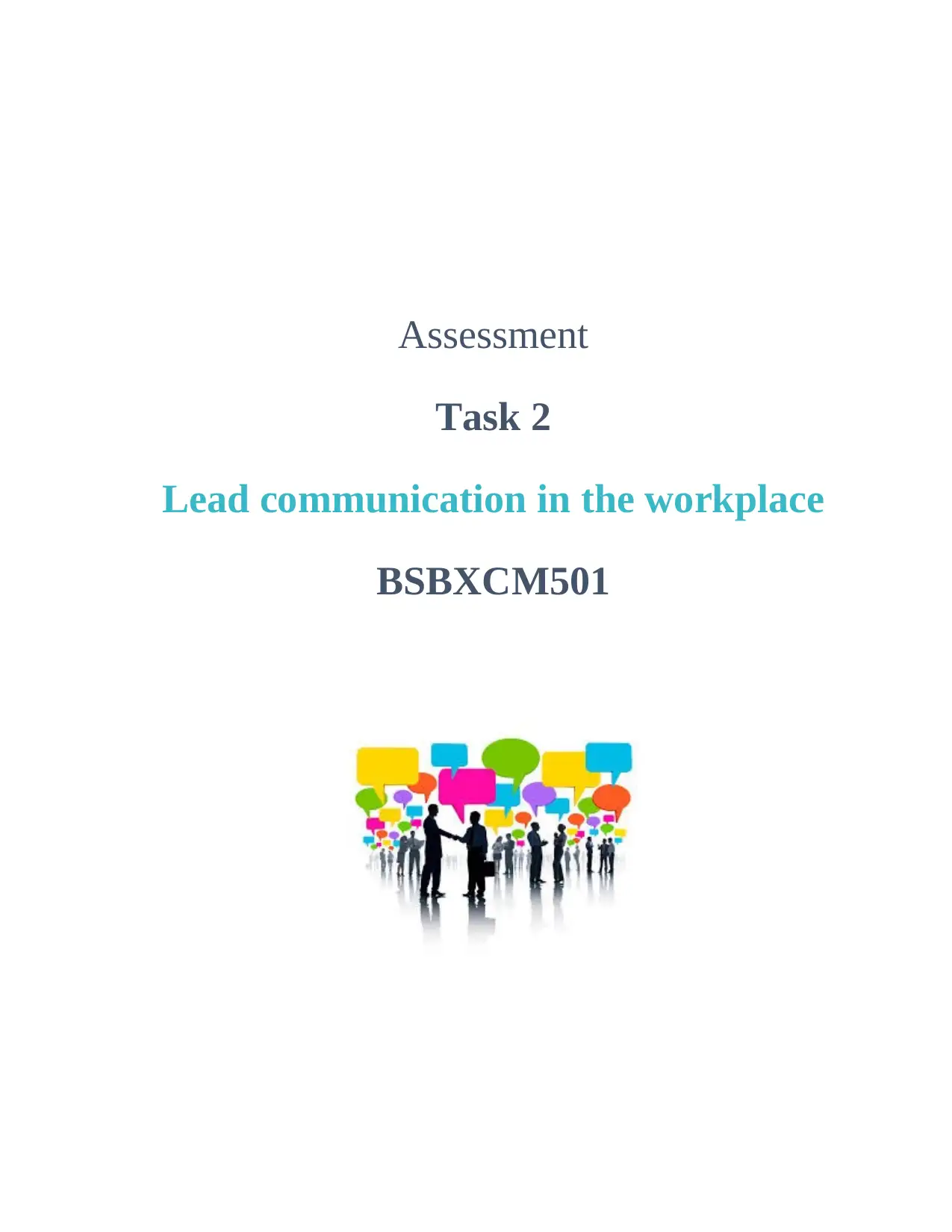
Assessment
Task 2
Lead communication in the workplace
BSBXCM501
Task 2
Lead communication in the workplace
BSBXCM501
Paraphrase This Document
Need a fresh take? Get an instant paraphrase of this document with our AI Paraphraser
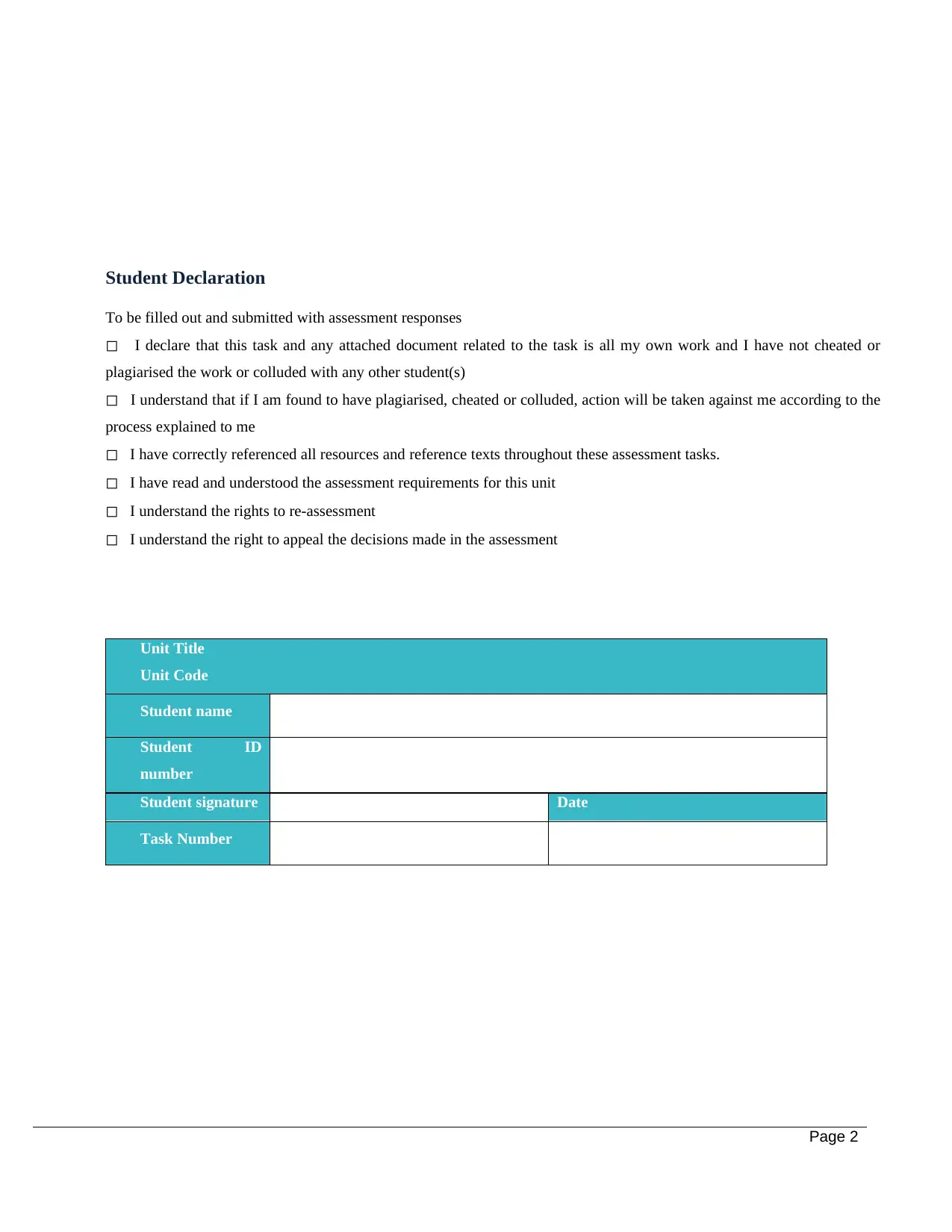
Student Declaration
To be filled out and submitted with assessment responses
◻ I declare that this task and any attached document related to the task is all my own work and I have not cheated or
plagiarised the work or colluded with any other student(s)
◻ I understand that if I am found to have plagiarised, cheated or colluded, action will be taken against me according to the
process explained to me
◻ I have correctly referenced all resources and reference texts throughout these assessment tasks.
◻ I have read and understood the assessment requirements for this unit
◻ I understand the rights to re-assessment
◻ I understand the right to appeal the decisions made in the assessment
Unit Title
Unit Code
Student name
Student ID
number
Student signature Date
Task Number
Page 2
To be filled out and submitted with assessment responses
◻ I declare that this task and any attached document related to the task is all my own work and I have not cheated or
plagiarised the work or colluded with any other student(s)
◻ I understand that if I am found to have plagiarised, cheated or colluded, action will be taken against me according to the
process explained to me
◻ I have correctly referenced all resources and reference texts throughout these assessment tasks.
◻ I have read and understood the assessment requirements for this unit
◻ I understand the rights to re-assessment
◻ I understand the right to appeal the decisions made in the assessment
Unit Title
Unit Code
Student name
Student ID
number
Student signature Date
Task Number
Page 2
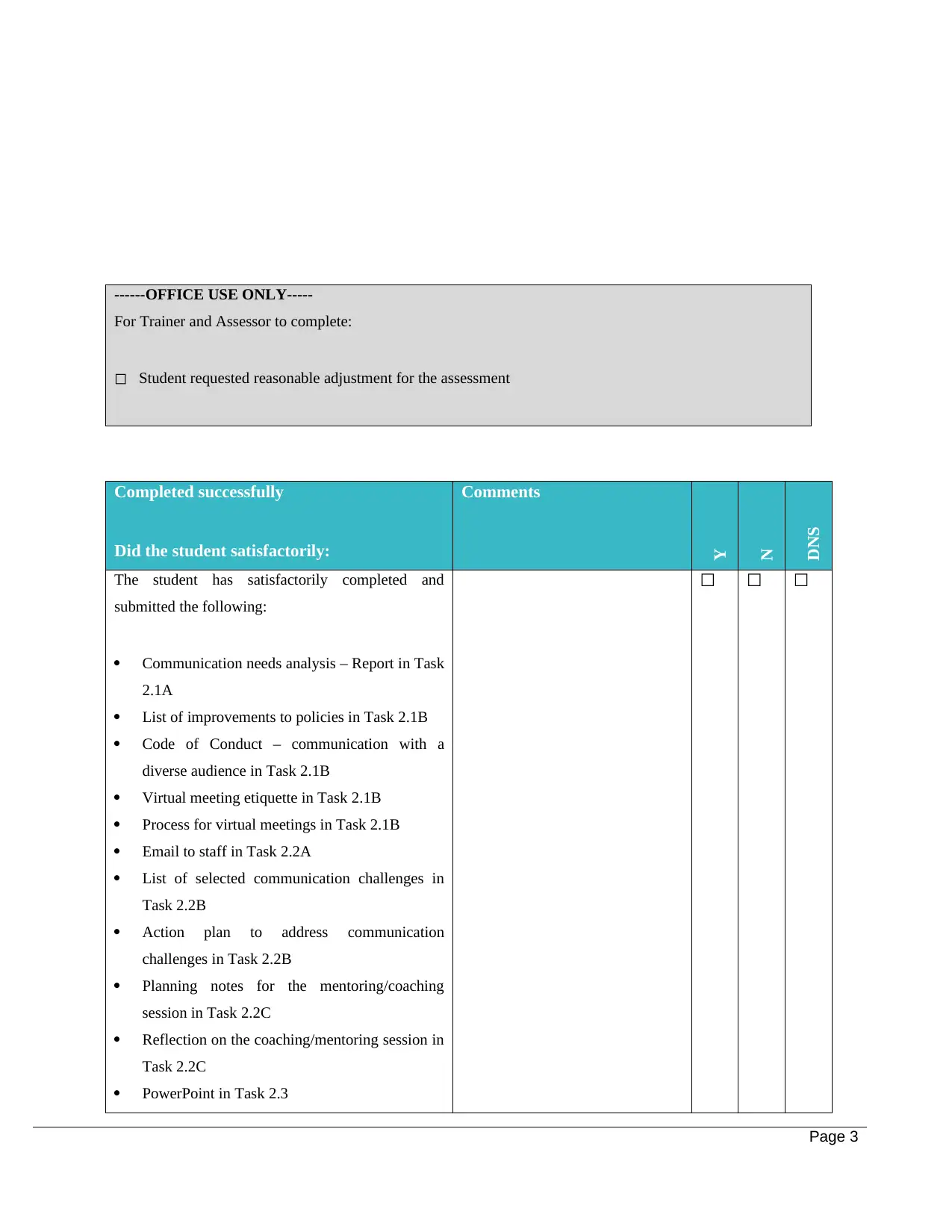
------OFFICE USE ONLY-----
For Trainer and Assessor to complete:
◻ Student requested reasonable adjustment for the assessment
Completed successfully
Did the student satisfactorily:
Comments
Y
N
DNS
The student has satisfactorily completed and
submitted the following:
Communication needs analysis – Report in Task
2.1A
List of improvements to policies in Task 2.1B
Code of Conduct – communication with a
diverse audience in Task 2.1B
Virtual meeting etiquette in Task 2.1B
Process for virtual meetings in Task 2.1B
Email to staff in Task 2.2A
List of selected communication challenges in
Task 2.2B
Action plan to address communication
challenges in Task 2.2B
Planning notes for the mentoring/coaching
session in Task 2.2C
Reflection on the coaching/mentoring session in
Task 2.2C
PowerPoint in Task 2.3
☐ ☐ ☐
Page 3
For Trainer and Assessor to complete:
◻ Student requested reasonable adjustment for the assessment
Completed successfully
Did the student satisfactorily:
Comments
Y
N
DNS
The student has satisfactorily completed and
submitted the following:
Communication needs analysis – Report in Task
2.1A
List of improvements to policies in Task 2.1B
Code of Conduct – communication with a
diverse audience in Task 2.1B
Virtual meeting etiquette in Task 2.1B
Process for virtual meetings in Task 2.1B
Email to staff in Task 2.2A
List of selected communication challenges in
Task 2.2B
Action plan to address communication
challenges in Task 2.2B
Planning notes for the mentoring/coaching
session in Task 2.2C
Reflection on the coaching/mentoring session in
Task 2.2C
PowerPoint in Task 2.3
☐ ☐ ☐
Page 3
⊘ This is a preview!⊘
Do you want full access?
Subscribe today to unlock all pages.

Trusted by 1+ million students worldwide
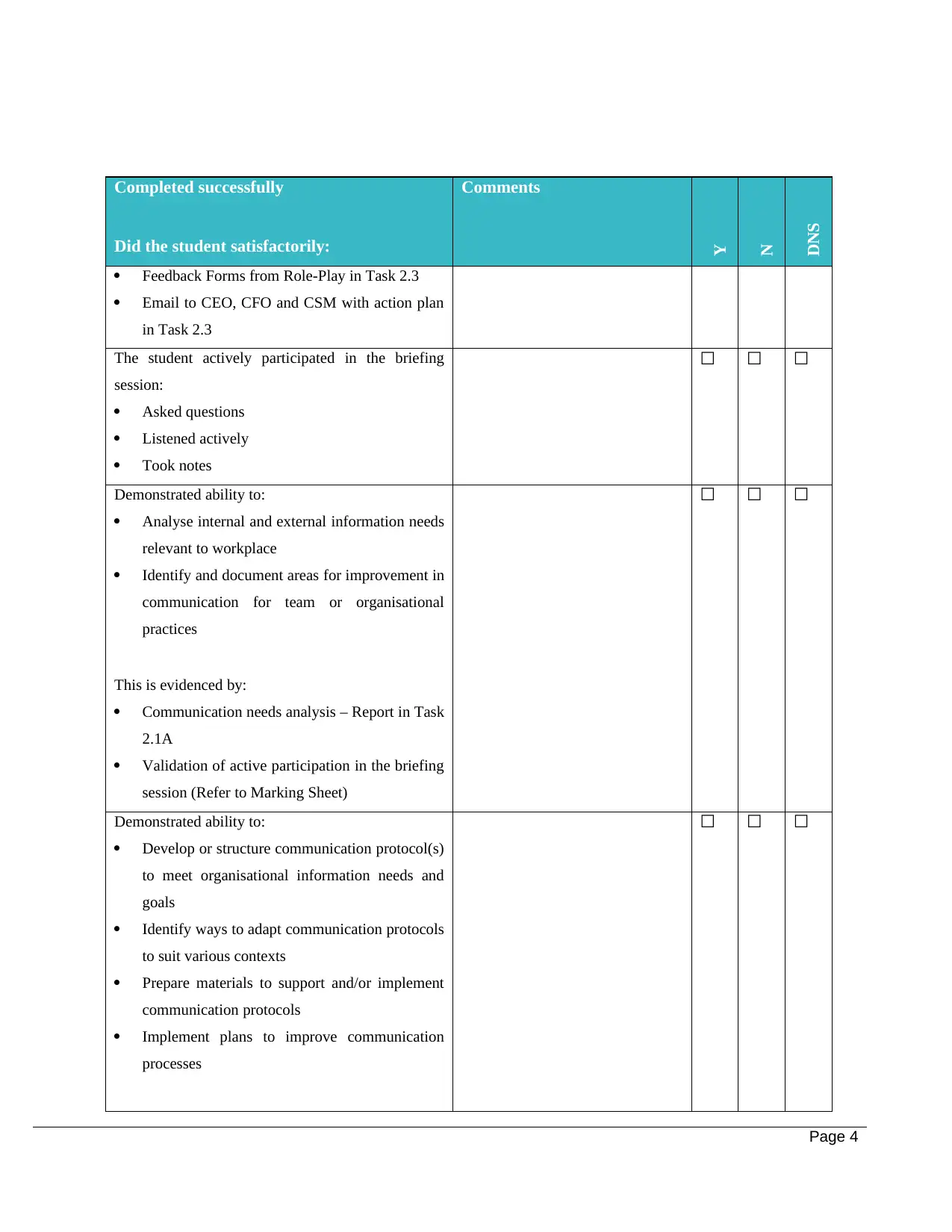
Completed successfully
Did the student satisfactorily:
Comments
Y
N
DNS
Feedback Forms from Role-Play in Task 2.3
Email to CEO, CFO and CSM with action plan
in Task 2.3
The student actively participated in the briefing
session:
Asked questions
Listened actively
Took notes
☐ ☐ ☐
Demonstrated ability to:
Analyse internal and external information needs
relevant to workplace
Identify and document areas for improvement in
communication for team or organisational
practices
This is evidenced by:
Communication needs analysis – Report in Task
2.1A
Validation of active participation in the briefing
session (Refer to Marking Sheet)
☐ ☐ ☐
Demonstrated ability to:
Develop or structure communication protocol(s)
to meet organisational information needs and
goals
Identify ways to adapt communication protocols
to suit various contexts
Prepare materials to support and/or implement
communication protocols
Implement plans to improve communication
processes
☐ ☐ ☐
Page 4
Did the student satisfactorily:
Comments
Y
N
DNS
Feedback Forms from Role-Play in Task 2.3
Email to CEO, CFO and CSM with action plan
in Task 2.3
The student actively participated in the briefing
session:
Asked questions
Listened actively
Took notes
☐ ☐ ☐
Demonstrated ability to:
Analyse internal and external information needs
relevant to workplace
Identify and document areas for improvement in
communication for team or organisational
practices
This is evidenced by:
Communication needs analysis – Report in Task
2.1A
Validation of active participation in the briefing
session (Refer to Marking Sheet)
☐ ☐ ☐
Demonstrated ability to:
Develop or structure communication protocol(s)
to meet organisational information needs and
goals
Identify ways to adapt communication protocols
to suit various contexts
Prepare materials to support and/or implement
communication protocols
Implement plans to improve communication
processes
☐ ☐ ☐
Page 4
Paraphrase This Document
Need a fresh take? Get an instant paraphrase of this document with our AI Paraphraser
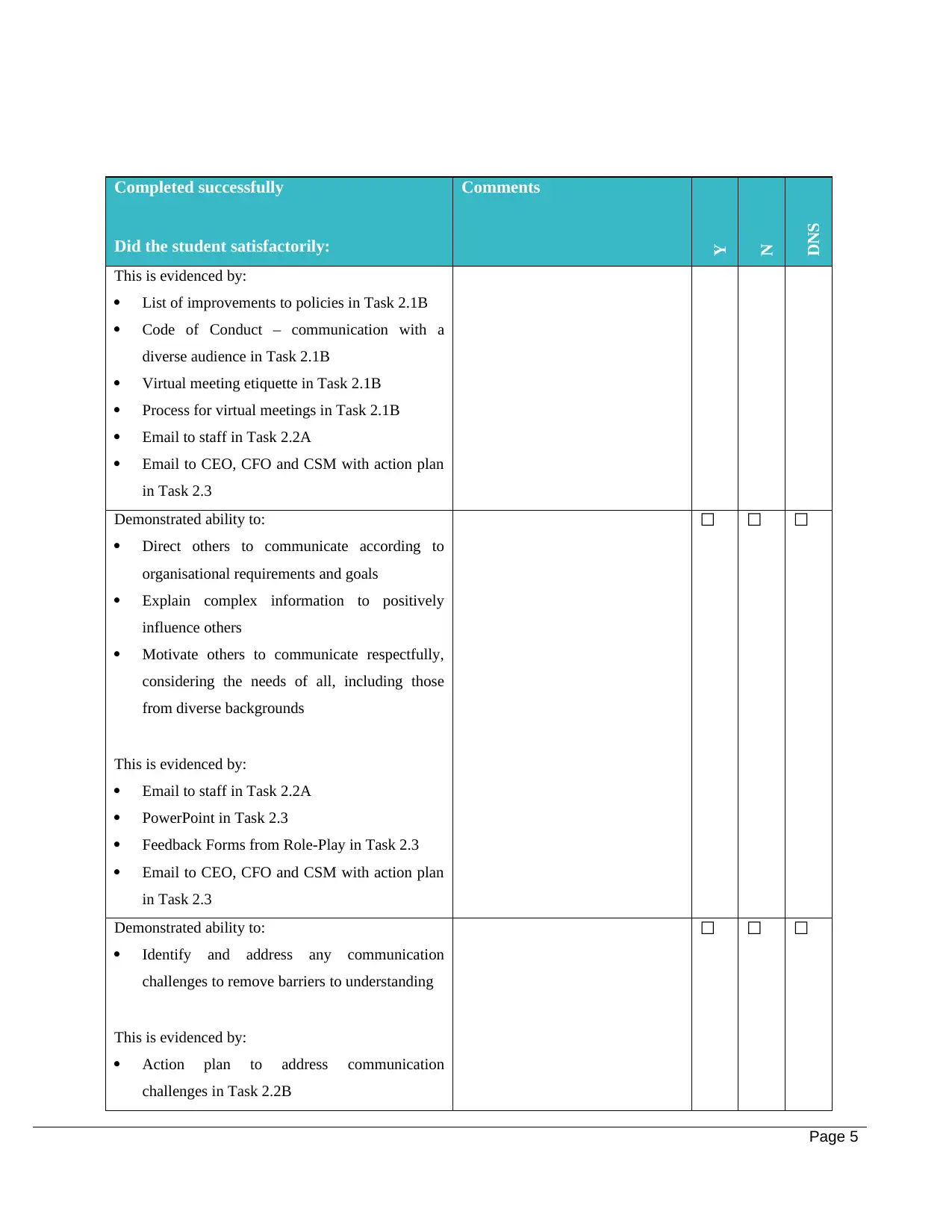
Completed successfully
Did the student satisfactorily:
Comments
Y
N
DNS
This is evidenced by:
List of improvements to policies in Task 2.1B
Code of Conduct – communication with a
diverse audience in Task 2.1B
Virtual meeting etiquette in Task 2.1B
Process for virtual meetings in Task 2.1B
Email to staff in Task 2.2A
Email to CEO, CFO and CSM with action plan
in Task 2.3
Demonstrated ability to:
Direct others to communicate according to
organisational requirements and goals
Explain complex information to positively
influence others
Motivate others to communicate respectfully,
considering the needs of all, including those
from diverse backgrounds
This is evidenced by:
Email to staff in Task 2.2A
PowerPoint in Task 2.3
Feedback Forms from Role-Play in Task 2.3
Email to CEO, CFO and CSM with action plan
in Task 2.3
☐ ☐ ☐
Demonstrated ability to:
Identify and address any communication
challenges to remove barriers to understanding
This is evidenced by:
Action plan to address communication
challenges in Task 2.2B
☐ ☐ ☐
Page 5
Did the student satisfactorily:
Comments
Y
N
DNS
This is evidenced by:
List of improvements to policies in Task 2.1B
Code of Conduct – communication with a
diverse audience in Task 2.1B
Virtual meeting etiquette in Task 2.1B
Process for virtual meetings in Task 2.1B
Email to staff in Task 2.2A
Email to CEO, CFO and CSM with action plan
in Task 2.3
Demonstrated ability to:
Direct others to communicate according to
organisational requirements and goals
Explain complex information to positively
influence others
Motivate others to communicate respectfully,
considering the needs of all, including those
from diverse backgrounds
This is evidenced by:
Email to staff in Task 2.2A
PowerPoint in Task 2.3
Feedback Forms from Role-Play in Task 2.3
Email to CEO, CFO and CSM with action plan
in Task 2.3
☐ ☐ ☐
Demonstrated ability to:
Identify and address any communication
challenges to remove barriers to understanding
This is evidenced by:
Action plan to address communication
challenges in Task 2.2B
☐ ☐ ☐
Page 5
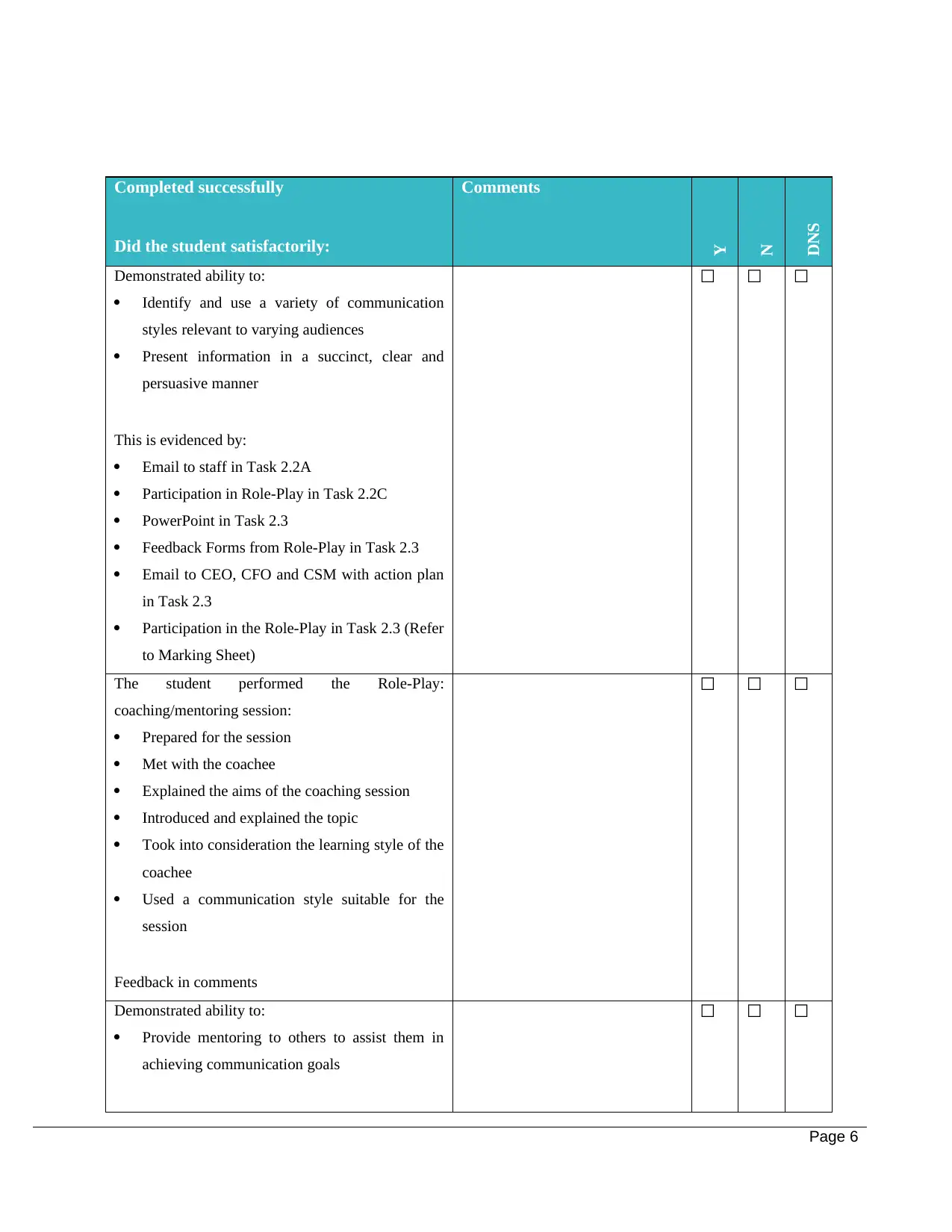
Completed successfully
Did the student satisfactorily:
Comments
Y
N
DNS
Demonstrated ability to:
Identify and use a variety of communication
styles relevant to varying audiences
Present information in a succinct, clear and
persuasive manner
This is evidenced by:
Email to staff in Task 2.2A
Participation in Role-Play in Task 2.2C
PowerPoint in Task 2.3
Feedback Forms from Role-Play in Task 2.3
Email to CEO, CFO and CSM with action plan
in Task 2.3
Participation in the Role-Play in Task 2.3 (Refer
to Marking Sheet)
☐ ☐ ☐
The student performed the Role-Play:
coaching/mentoring session:
Prepared for the session
Met with the coachee
Explained the aims of the coaching session
Introduced and explained the topic
Took into consideration the learning style of the
coachee
Used a communication style suitable for the
session
Feedback in comments
☐ ☐ ☐
Demonstrated ability to:
Provide mentoring to others to assist them in
achieving communication goals
☐ ☐ ☐
Page 6
Did the student satisfactorily:
Comments
Y
N
DNS
Demonstrated ability to:
Identify and use a variety of communication
styles relevant to varying audiences
Present information in a succinct, clear and
persuasive manner
This is evidenced by:
Email to staff in Task 2.2A
Participation in Role-Play in Task 2.2C
PowerPoint in Task 2.3
Feedback Forms from Role-Play in Task 2.3
Email to CEO, CFO and CSM with action plan
in Task 2.3
Participation in the Role-Play in Task 2.3 (Refer
to Marking Sheet)
☐ ☐ ☐
The student performed the Role-Play:
coaching/mentoring session:
Prepared for the session
Met with the coachee
Explained the aims of the coaching session
Introduced and explained the topic
Took into consideration the learning style of the
coachee
Used a communication style suitable for the
session
Feedback in comments
☐ ☐ ☐
Demonstrated ability to:
Provide mentoring to others to assist them in
achieving communication goals
☐ ☐ ☐
Page 6
⊘ This is a preview!⊘
Do you want full access?
Subscribe today to unlock all pages.

Trusted by 1+ million students worldwide
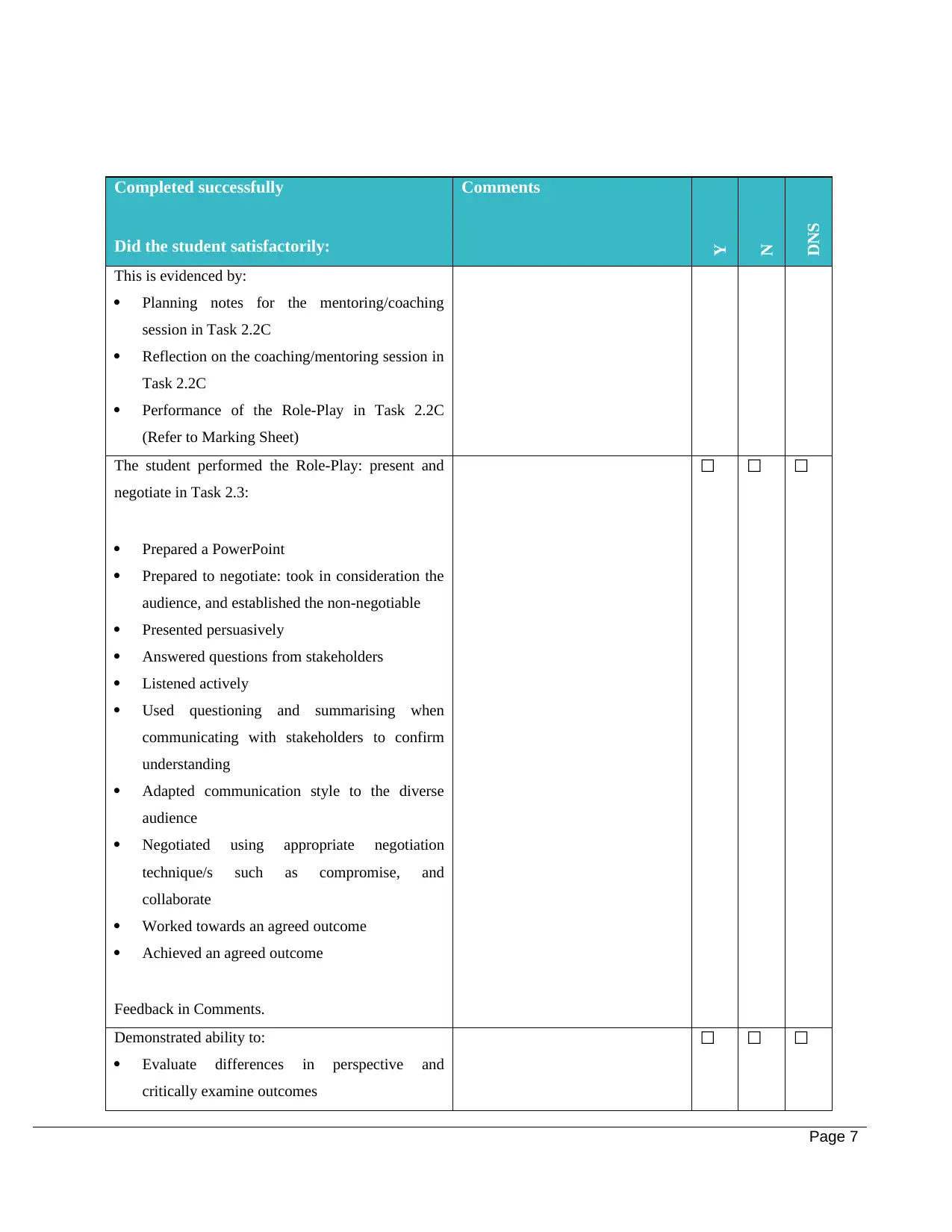
Completed successfully
Did the student satisfactorily:
Comments
Y
N
DNS
This is evidenced by:
Planning notes for the mentoring/coaching
session in Task 2.2C
Reflection on the coaching/mentoring session in
Task 2.2C
Performance of the Role-Play in Task 2.2C
(Refer to Marking Sheet)
The student performed the Role-Play: present and
negotiate in Task 2.3:
Prepared a PowerPoint
Prepared to negotiate: took in consideration the
audience, and established the non-negotiable
Presented persuasively
Answered questions from stakeholders
Listened actively
Used questioning and summarising when
communicating with stakeholders to confirm
understanding
Adapted communication style to the diverse
audience
Negotiated using appropriate negotiation
technique/s such as compromise, and
collaborate
Worked towards an agreed outcome
Achieved an agreed outcome
Feedback in Comments.
☐ ☐ ☐
Demonstrated ability to:
Evaluate differences in perspective and
critically examine outcomes
☐ ☐ ☐
Page 7
Did the student satisfactorily:
Comments
Y
N
DNS
This is evidenced by:
Planning notes for the mentoring/coaching
session in Task 2.2C
Reflection on the coaching/mentoring session in
Task 2.2C
Performance of the Role-Play in Task 2.2C
(Refer to Marking Sheet)
The student performed the Role-Play: present and
negotiate in Task 2.3:
Prepared a PowerPoint
Prepared to negotiate: took in consideration the
audience, and established the non-negotiable
Presented persuasively
Answered questions from stakeholders
Listened actively
Used questioning and summarising when
communicating with stakeholders to confirm
understanding
Adapted communication style to the diverse
audience
Negotiated using appropriate negotiation
technique/s such as compromise, and
collaborate
Worked towards an agreed outcome
Achieved an agreed outcome
Feedback in Comments.
☐ ☐ ☐
Demonstrated ability to:
Evaluate differences in perspective and
critically examine outcomes
☐ ☐ ☐
Page 7
Paraphrase This Document
Need a fresh take? Get an instant paraphrase of this document with our AI Paraphraser
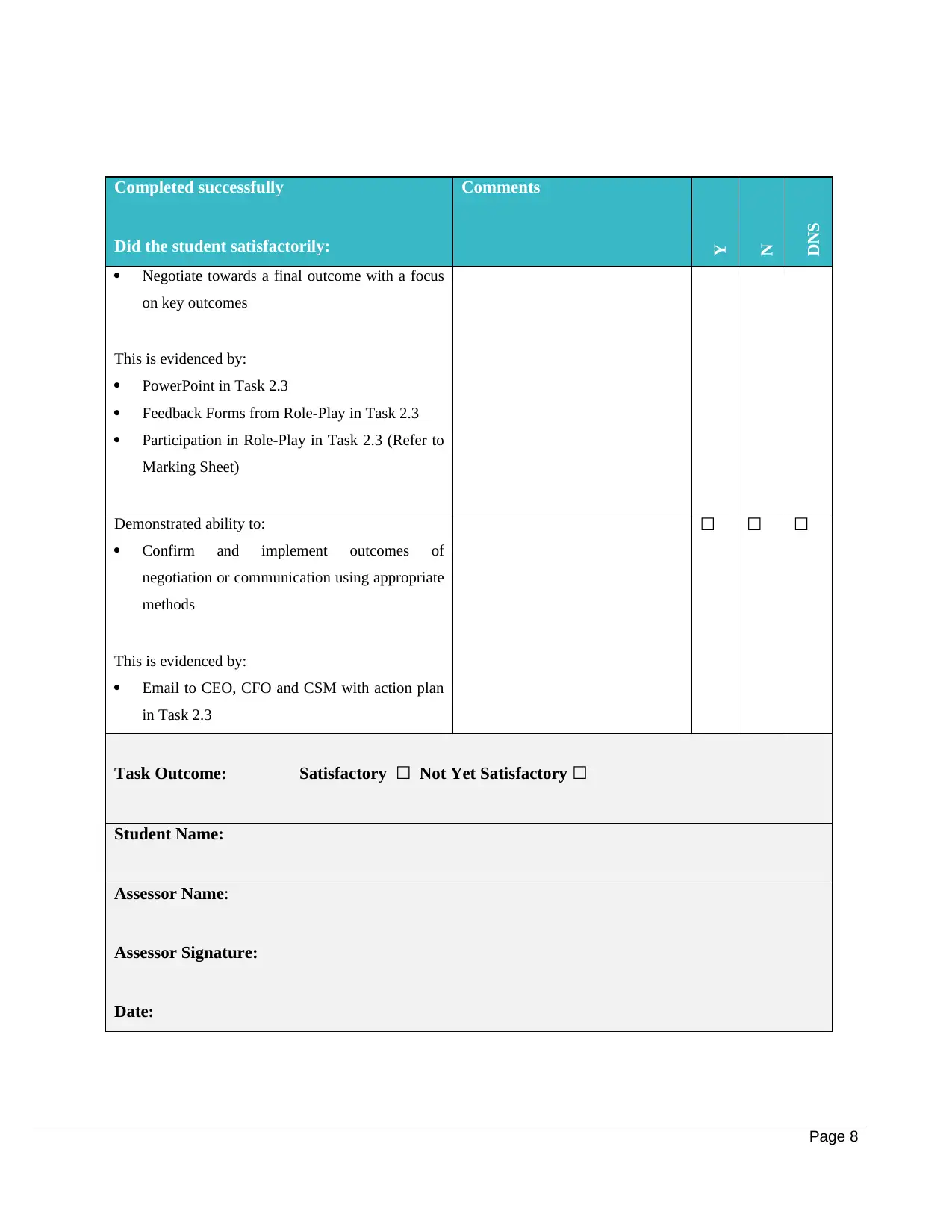
Completed successfully
Did the student satisfactorily:
Comments
Y
N
DNS
Negotiate towards a final outcome with a focus
on key outcomes
This is evidenced by:
PowerPoint in Task 2.3
Feedback Forms from Role-Play in Task 2.3
Participation in Role-Play in Task 2.3 (Refer to
Marking Sheet)
Demonstrated ability to:
Confirm and implement outcomes of
negotiation or communication using appropriate
methods
This is evidenced by:
Email to CEO, CFO and CSM with action plan
in Task 2.3
☐ ☐ ☐
Task Outcome: Satisfactory ☐ Not Yet Satisfactory ☐
Student Name:
Assessor Name:
Assessor Signature:
Date:
Page 8
Did the student satisfactorily:
Comments
Y
N
DNS
Negotiate towards a final outcome with a focus
on key outcomes
This is evidenced by:
PowerPoint in Task 2.3
Feedback Forms from Role-Play in Task 2.3
Participation in Role-Play in Task 2.3 (Refer to
Marking Sheet)
Demonstrated ability to:
Confirm and implement outcomes of
negotiation or communication using appropriate
methods
This is evidenced by:
Email to CEO, CFO and CSM with action plan
in Task 2.3
☐ ☐ ☐
Task Outcome: Satisfactory ☐ Not Yet Satisfactory ☐
Student Name:
Assessor Name:
Assessor Signature:
Date:
Page 8
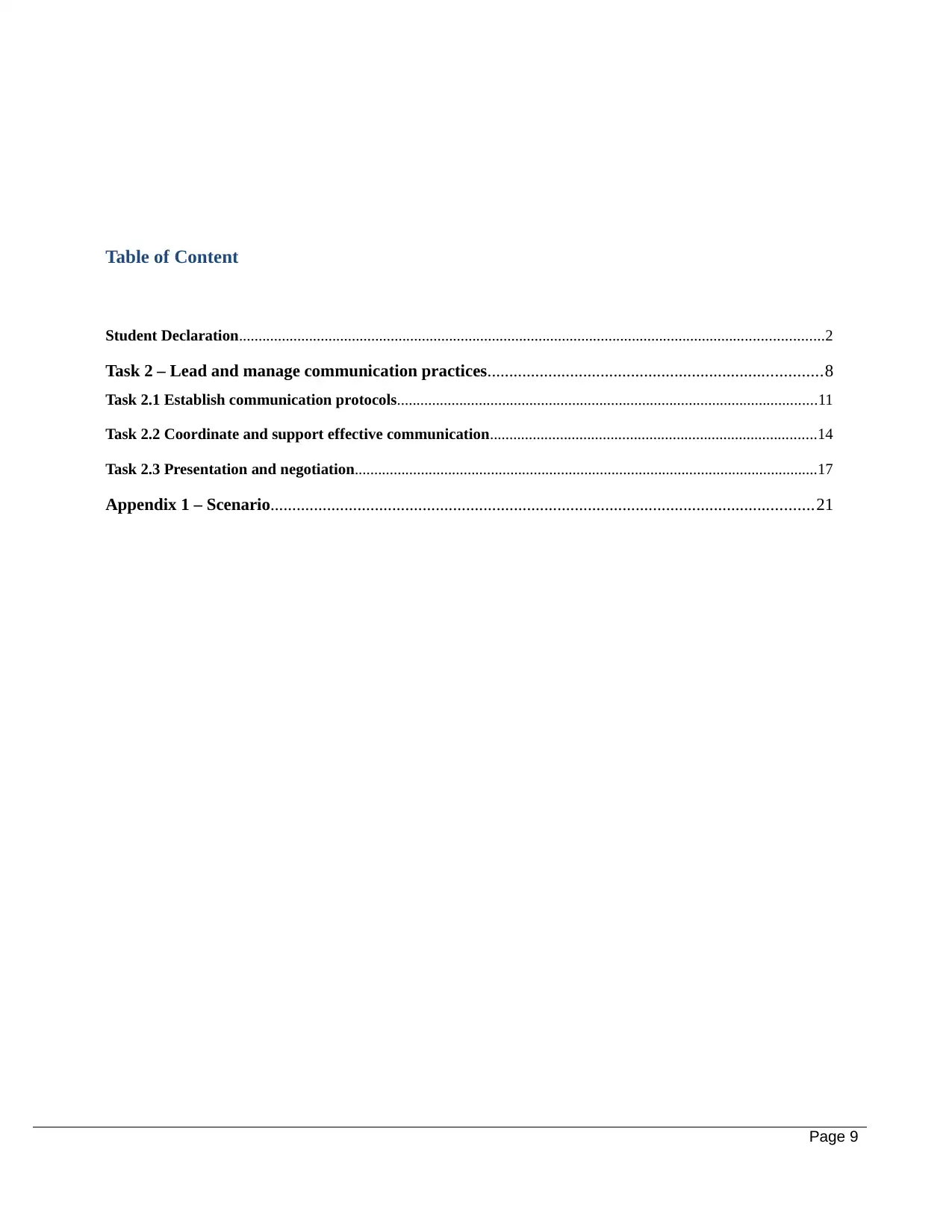
Table of Content
Student Declaration......................................................................................................................................................2
Task 2 – Lead and manage communication practices.............................................................................8
Task 2.1 Establish communication protocols............................................................................................................11
Task 2.2 Coordinate and support effective communication....................................................................................14
Task 2.3 Presentation and negotiation.......................................................................................................................17
Appendix 1 – Scenario.............................................................................................................................21
Page 9
Student Declaration......................................................................................................................................................2
Task 2 – Lead and manage communication practices.............................................................................8
Task 2.1 Establish communication protocols............................................................................................................11
Task 2.2 Coordinate and support effective communication....................................................................................14
Task 2.3 Presentation and negotiation.......................................................................................................................17
Appendix 1 – Scenario.............................................................................................................................21
Page 9
⊘ This is a preview!⊘
Do you want full access?
Subscribe today to unlock all pages.

Trusted by 1+ million students worldwide
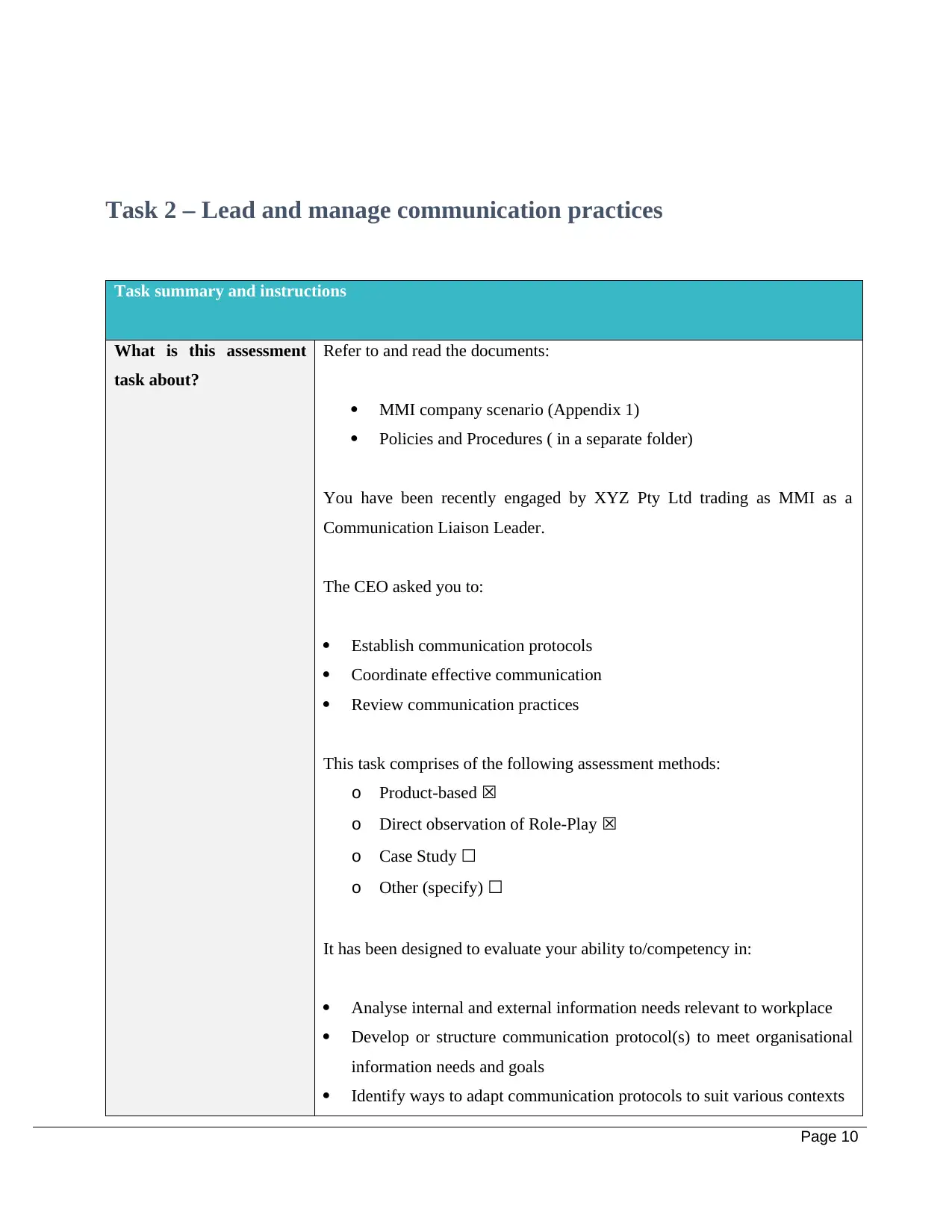
Task 2 – Lead and manage communication practices
Task summary and instructions
What is this assessment
task about?
Refer to and read the documents:
MMI company scenario (Appendix 1)
Policies and Procedures ( in a separate folder)
You have been recently engaged by XYZ Pty Ltd trading as MMI as a
Communication Liaison Leader.
The CEO asked you to:
Establish communication protocols
Coordinate effective communication
Review communication practices
This task comprises of the following assessment methods:
o Product-based ☒
o Direct observation of Role-Play ☒
o Case Study ☐
o Other (specify) ☐
It has been designed to evaluate your ability to/competency in:
Analyse internal and external information needs relevant to workplace
Develop or structure communication protocol(s) to meet organisational
information needs and goals
Identify ways to adapt communication protocols to suit various contexts
Page 10
Task summary and instructions
What is this assessment
task about?
Refer to and read the documents:
MMI company scenario (Appendix 1)
Policies and Procedures ( in a separate folder)
You have been recently engaged by XYZ Pty Ltd trading as MMI as a
Communication Liaison Leader.
The CEO asked you to:
Establish communication protocols
Coordinate effective communication
Review communication practices
This task comprises of the following assessment methods:
o Product-based ☒
o Direct observation of Role-Play ☒
o Case Study ☐
o Other (specify) ☐
It has been designed to evaluate your ability to/competency in:
Analyse internal and external information needs relevant to workplace
Develop or structure communication protocol(s) to meet organisational
information needs and goals
Identify ways to adapt communication protocols to suit various contexts
Page 10
Paraphrase This Document
Need a fresh take? Get an instant paraphrase of this document with our AI Paraphraser
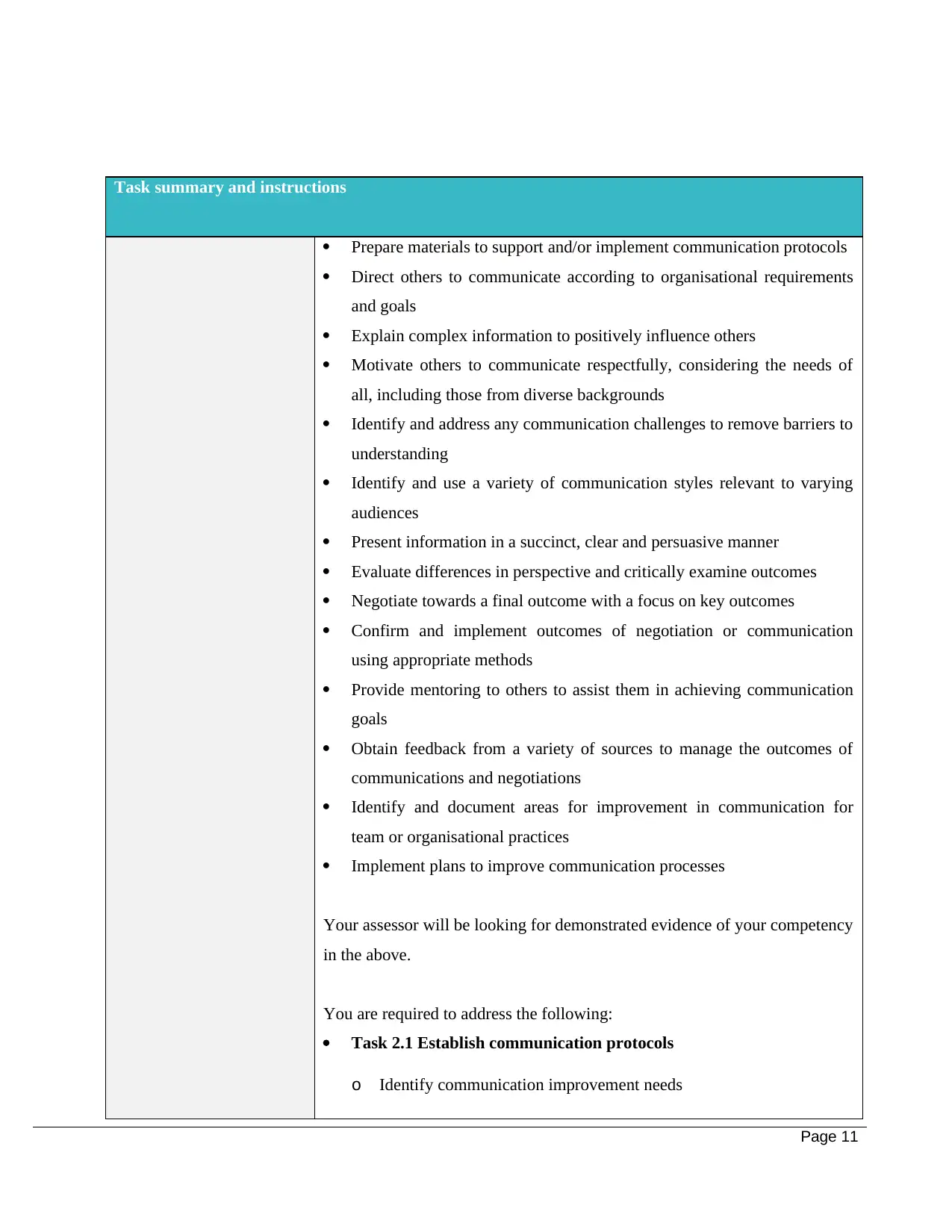
Task summary and instructions
Prepare materials to support and/or implement communication protocols
Direct others to communicate according to organisational requirements
and goals
Explain complex information to positively influence others
Motivate others to communicate respectfully, considering the needs of
all, including those from diverse backgrounds
Identify and address any communication challenges to remove barriers to
understanding
Identify and use a variety of communication styles relevant to varying
audiences
Present information in a succinct, clear and persuasive manner
Evaluate differences in perspective and critically examine outcomes
Negotiate towards a final outcome with a focus on key outcomes
Confirm and implement outcomes of negotiation or communication
using appropriate methods
Provide mentoring to others to assist them in achieving communication
goals
Obtain feedback from a variety of sources to manage the outcomes of
communications and negotiations
Identify and document areas for improvement in communication for
team or organisational practices
Implement plans to improve communication processes
Your assessor will be looking for demonstrated evidence of your competency
in the above.
You are required to address the following:
Task 2.1 Establish communication protocols
o Identify communication improvement needs
Page 11
Prepare materials to support and/or implement communication protocols
Direct others to communicate according to organisational requirements
and goals
Explain complex information to positively influence others
Motivate others to communicate respectfully, considering the needs of
all, including those from diverse backgrounds
Identify and address any communication challenges to remove barriers to
understanding
Identify and use a variety of communication styles relevant to varying
audiences
Present information in a succinct, clear and persuasive manner
Evaluate differences in perspective and critically examine outcomes
Negotiate towards a final outcome with a focus on key outcomes
Confirm and implement outcomes of negotiation or communication
using appropriate methods
Provide mentoring to others to assist them in achieving communication
goals
Obtain feedback from a variety of sources to manage the outcomes of
communications and negotiations
Identify and document areas for improvement in communication for
team or organisational practices
Implement plans to improve communication processes
Your assessor will be looking for demonstrated evidence of your competency
in the above.
You are required to address the following:
Task 2.1 Establish communication protocols
o Identify communication improvement needs
Page 11
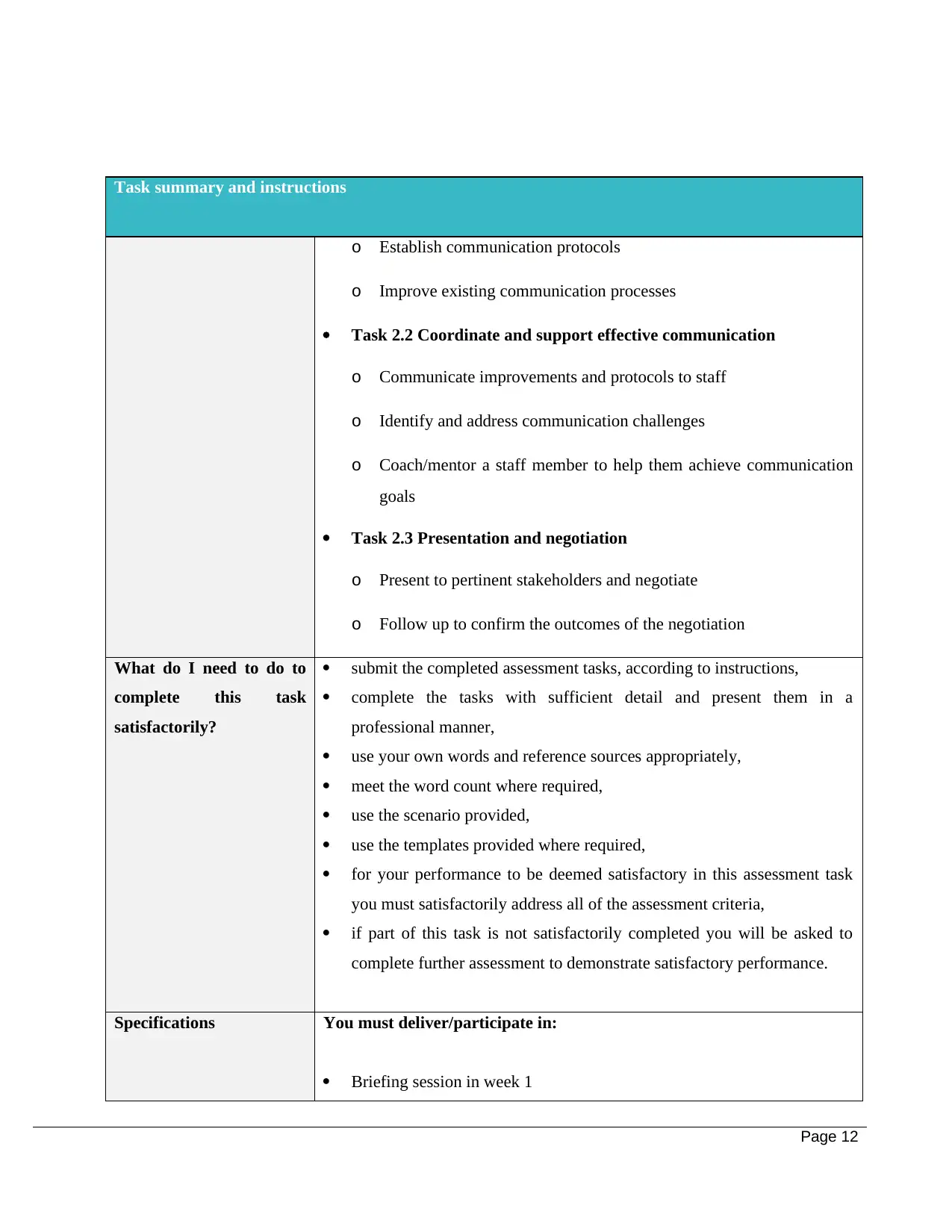
Task summary and instructions
o Establish communication protocols
o Improve existing communication processes
Task 2.2 Coordinate and support effective communication
o Communicate improvements and protocols to staff
o Identify and address communication challenges
o Coach/mentor a staff member to help them achieve communication
goals
Task 2.3 Presentation and negotiation
o Present to pertinent stakeholders and negotiate
o Follow up to confirm the outcomes of the negotiation
What do I need to do to
complete this task
satisfactorily?
submit the completed assessment tasks, according to instructions,
complete the tasks with sufficient detail and present them in a
professional manner,
use your own words and reference sources appropriately,
meet the word count where required,
use the scenario provided,
use the templates provided where required,
for your performance to be deemed satisfactory in this assessment task
you must satisfactorily address all of the assessment criteria,
if part of this task is not satisfactorily completed you will be asked to
complete further assessment to demonstrate satisfactory performance.
Specifications You must deliver/participate in:
Briefing session in week 1
Page 12
o Establish communication protocols
o Improve existing communication processes
Task 2.2 Coordinate and support effective communication
o Communicate improvements and protocols to staff
o Identify and address communication challenges
o Coach/mentor a staff member to help them achieve communication
goals
Task 2.3 Presentation and negotiation
o Present to pertinent stakeholders and negotiate
o Follow up to confirm the outcomes of the negotiation
What do I need to do to
complete this task
satisfactorily?
submit the completed assessment tasks, according to instructions,
complete the tasks with sufficient detail and present them in a
professional manner,
use your own words and reference sources appropriately,
meet the word count where required,
use the scenario provided,
use the templates provided where required,
for your performance to be deemed satisfactory in this assessment task
you must satisfactorily address all of the assessment criteria,
if part of this task is not satisfactorily completed you will be asked to
complete further assessment to demonstrate satisfactory performance.
Specifications You must deliver/participate in:
Briefing session in week 1
Page 12
⊘ This is a preview!⊘
Do you want full access?
Subscribe today to unlock all pages.

Trusted by 1+ million students worldwide
1 out of 40
Related Documents
Your All-in-One AI-Powered Toolkit for Academic Success.
+13062052269
info@desklib.com
Available 24*7 on WhatsApp / Email
![[object Object]](/_next/static/media/star-bottom.7253800d.svg)
Unlock your academic potential
Copyright © 2020–2025 A2Z Services. All Rights Reserved. Developed and managed by ZUCOL.



